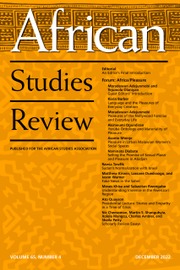The book interrogates the dilemma of state efforts in addressing nativist tendencies and xenophobic violence without first addressing the socioeconomic conditions that make such behaviour inevitable in Africa’s postcolonial era. Xenophobia and nativism are historic global phenomena that continue to frustrate the attainment of the laudable goals of Pan-Africanism in the twenty-first century and important development initiatives in postcolonial Africa.
Using Samuel P. Huntington’s thesis on how cultural differences would underpin the central casus belli in the post–Cold War international system, Emmanuel Kasonde Matambo frames xenophobia and nativism as global issues that are not pathological to, but endemic in, the African continent. Although these phenomena have cultural underpinnings, they are often triggered by the feeling that the socioeconomic miseries experienced by the natives are caused by their marginalization, disenchantment, and ostracization from the state’s critical political and economic institutions. It is for this reason that, Matambo argues, nativists harbor resentment for foreign nationals, providing avenues for nativist sects, populist groups, deprived natives, and politicians to problematize foreigners as job stealers and the government that refuses to evict them as sellouts. The American presidential election of 2016 corroborates the author’s claim, considering that President Donald Trump weaponized anti-foreigner and specifically anti-black and anti-China rhetorics as a populist strategy of advancing his political ambitions by demonizing immigrants as threats to America’s national security and economy. The peddling of these anti-immigrant stereotypes and slurs triggered attacks on Asians and black nationals in the United States, just as the attacks on foreigners in South Africa (3).
South Africa is the epicentre of nativist and xenophobic (Afro-phobic) violence in Africa. Unsurprisingly, seven of the book’s thirteen chapters interrogate the different dimensions of these phenomena in the Rainbow Nation. Arguably, state failure and the inability of the postcolonial African states to effectively address the development crisis exacerbated by the implementation of neoliberal policies is at the core of the crisis of indigeneity and the surge of anti-immigrant hate and violence that continue to ravage the continent. However, although xenophobia and nativism are social phenomena with an economic undertone, they also have, Matambo argues, a psychological undertone that makes them amenable to ideological interventions—such as the use of the Siswati adage live liyengcayelwa as an African philosophical-ethical tool of promoting mutual respect among black South African population and black immigrants (168).
The concept of coloniality of being is an important frame that Robert Maseko uses to unpack xenophobia, nativism, and violence targeted mostly at black immigrants as against the white and Asian population in South Africa. Two important factors, notably the social construction of being along racial lines and the relics of apartheid in postapartheid South Africa, explain this contrast. As Maseko suggests, the racial construction of being superior (white) and inferior (black) that fosters the perpetuation of the subaltern identity of blackness in national policies and institutions of postapartheid South Africa are such that justify the labeling and problematization of black immigrants as criminals who must be attacked, evicted, and killed because of skin color (75).
Secondly, the relics of apartheid—that is, the discriminatory institutions and machinery it set in place to perpetuate the coloniality of power and attendant socioeconomic inequalities, deprivations, and poverty among the marginalized black majority—are such that impel black South Africans to deploy mayhem on black immigrants instead of on their oppressors. Maseko argues that this impelled the reconceptualization of xenophobia in South Africa as Afro-phobia, given that black immigrants are labeled as job and opportunity takers and are often the victims of aggression and violence by the marginalized black South Africans (159).
In other sections of his book, Matambo argues that despite the existence of several peace-building initiatives that have been set in motion; these are often impeded by repressive government policies, actions, and the reactions of traditional leaders, all of which embolden the perpetrators of Afro-phobic violence as justifiably right. The African National Congress (ANC) used the strategy of distracting South Africans from its failures by denying Afro-phobic attacks on black immigrants, and it did so through its unfortunate portrayal of the violence as criminal rather than xenophobic. This strategy has helped to exacerbate the Afro-phobic violence and tendencies among the deprived black South Africans. It has also emboldened acts such as the widespread online resentment of the black South African youths against Nigerian immigrants in South Africa due to the perceived preponderant socioeconomic influence of Nigerian immigrants in their towns and provinces. Morever, black South African dissidents ingeniously weaponized the criminalization of Nigerian and Zimbabwean “others” using the #ZimbabweansMustGo and #NigeriansMustGo to drive home the #PutSouthAfricansFirst agenda. Online activities such as these have, argued Matambo, emboldened the scapegoating of black immigrants and the normalizing of attacks, killings, and looting of shops and businesses owned by black immigrants, without just retribution. All this has had devastating effects on black immigrants in Gauteng, KwaZulu-Natal, and Limpopo, where the highest incidence of xenophobic attacks occurred (139).
Sky Mkuti argues in Chapter eleven that these experiences underscore the need for South Africa—and, by extension, African states—to spread the values of pan-Africanists beyond the confines of the few African elites and domesticate it among the “uneducated” Africans. Secondly, there is a need for the adoption of a pan-Africanist development model that gives credence to the historical subjugation of the African people and prioritizes the attainment of a better quality of life for the black race. Overall, the book exposes the evil of Afro-phobia in South Africa, drawing from its multidimensional perspectives. However, none of the chapters propose a specific intervention for unlearning the psychosocial tendency for hate towards black immigrants. Nevertheless, it proposes the embracement of Pan-Africanist values of the brotherhood of the African people as a panacea for Afro-phobia in South Africa.

